语法 一般过去时
一般过去时.语法讲解PPT

一般过去时常用的时间状语包括过去的时间点、过去的时间段 等,而过去完成时常用的时间状语包括“已经”、“之前”等
。
05
一般过去时的练习与巩固
填空练习
总结词
填空练习是巩固一般过去时的有效方法,通过在句子中留空,让学生填写正确的动词时态,加深对一般过去时的 理解和运用。
详细描述
在填空练习中,教师可以选择一些包含一般过去时的句子,故意去掉动词时态部分,让学生根据上下文语境和时 态规则填写正确的时态。例如,“Yesterday, I ____(go) to the park with my family. We ____ (have) a great time.” 学生应该填写“went”和“had”。
表示过去的习惯或经常发生的动作
描述过去的习惯
一般过去时可以用来描述过去经常发 生的动作或习惯,例如“He used to smoke a pack of cigarettes a day” (他以前每天抽一包烟)。
描述过去的频率
一般过去时可以用来表示过去某个时间 段内发生的动作的频率,例如“We met every week”(我们每周见面一 次)。
一般过去时表示动作已经完成,而过去进行时则表示动作正在进行中。
总结词
时间状语不同
详细描述
一般过去时常用的时间状语包括过去的时间点、过去的时间段等,而 过去进行时常用的时间状语包括“当时”、“正在”等。
与过去完成时混淆的用法
总结词 详细描述
总结词 详细描述
动作是否完成
一般过去时表示动作已经完成,而过去完成时则表示在过去的 某个时间点之前已经完成的动作。
选择练习
总结词
选择练习是一种常见的练习方式,通过提供多个选项,让学生选择符合语境和语法规则的答案,进一 步巩固一般过去时的运用。
一般过去时的语法
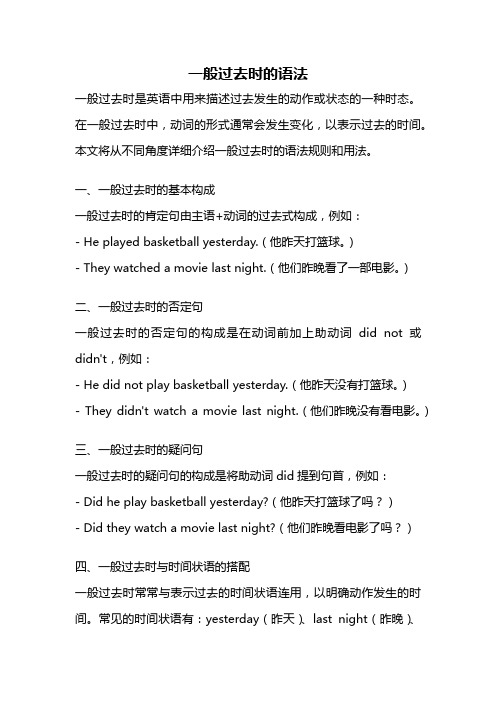
一般过去时的语法一般过去时是英语中用来描述过去发生的动作或状态的一种时态。
在一般过去时中,动词的形式通常会发生变化,以表示过去的时间。
本文将从不同角度详细介绍一般过去时的语法规则和用法。
一、一般过去时的基本构成一般过去时的肯定句由主语+动词的过去式构成,例如:- He played basketball yesterday.(他昨天打篮球。
)- They watched a movie last night.(他们昨晚看了一部电影。
)二、一般过去时的否定句一般过去时的否定句的构成是在动词前加上助动词did not或didn't,例如:- He did not play basketball yesterday.(他昨天没有打篮球。
)- They didn't watch a movie last night.(他们昨晚没有看电影。
)三、一般过去时的疑问句一般过去时的疑问句的构成是将助动词did提到句首,例如:- Did he play basketball yesterday?(他昨天打篮球了吗?)- Did they watch a movie last night?(他们昨晚看电影了吗?)四、一般过去时与时间状语的搭配一般过去时常常与表示过去的时间状语连用,以明确动作发生的时间。
常见的时间状语有:yesterday(昨天)、last night(昨晚)、last week(上周)、in 2010(在2010年)等等。
五、一般过去时的用法1. 表示过去发生的动作或状态She lived in New York for five years.(她在纽约住了五年。
)2. 表示过去经常或反复发生的动作He often went swimming when he was young.(他年轻时经常去游泳。
)3. 表示过去的习惯或常态She always cooked dinner for her family.(她过去总是为家人做晚饭。
英语一般过去时语法知识点

英语一般过去时语法知识点英语一般过去时(Simple Past Tense)是表示过去某个时间发生或存在的动作或状态的一种时态。
以下是英语一般过去时的语法知识点:1. 句子结构:主语+ 动词过去式+ 其他成分。
2. 动词过去式的构成:- 一般情况下,直接在动词原形后面加-ed。
例如:play →played,watch →watched,want →wanted。
- 以不发音的字母“e”结尾的动词,在加-ed前先去掉“e”。
例如:live →lived,change →changed。
- 以辅音字母+y结尾的动词,将y变为i再加-ed。
例如:study →studied,carry →carried。
- 一些不规则动词的过去式需要记忆,例如:go →went,eat →ate,see →saw,do →did。
3. 动词过去式的否定和疑问形式:- 否定形式:主语+ did not + 动词原形+ 其他成分。
缩写为didn't。
例如:I didn't play tennis yesterday.- 疑问形式:Did + 主语+ 动词原形+ 其他成分例如:Did you watch the movie last night?4. 一般过去时的时间状语:昨天(yesterday)、上个月(last month)、去年(last year)等表示过去某个具体时间的时间状语。
5. 一般过去时的用法:- 表示过去某个具体时间发生的动作或状态。
例如:I went to the beach yesterday.- 表示过去一段时间内发生的动作或状态。
例如:I lived in London for two years.- 表示过去习惯性的动作或状态。
例如:When I was a child, I always played with my friends.以上就是英语一般过去时的语法知识点。
记得多加练习,熟练掌握一般过去时的用法。
英语语法——一般过去时课件(共44张PPT)

肯否回答:
一般疑问句: Be动词(was/were)+主语+其他+?
肯定回答:Yes , 主语+ was/were. 否定回答:No , 主语+ wasn’t/weren’t . --- Was he at home yesterday ? ---他昨天在家吗? --- Yes , he was .是的,他在 --- No , he wasn’t . 不,他不在。
study — studied
carry— carried
5.不规则变化. (见不规则动词表P97)
be动词 的一般过去时
Please look at the sentences
我今年12岁. I _a_m_ 12 years old this year.
我去年11岁. I _w_a_s_ 11 years old last year.
实意动词的一般 过去时句子结构
每天,早餐我吃鸡蛋和牛奶。 I _h_av_e_ eggs and milk for breakfast every morning.
昨天,早餐我吃面条。
I _h_a_d_ noodles for breakfast yesterday morning.
他每天都吃水果。 He _h_a_s__ fruit every day.
1. I _______ at school now.
was 2. He ________ at the camp last week. were 3. We ________ students two years ago. were 4. They ________ on the farm a moment ago. was 5. Yang Ling ________ eleven years old last year. was 6. There ________ an apple on the plate yesterday. was 7. There ________ some milk in the fridge yesterday. was 8. The mobile phone _______ on the sofa yesterday evening.
一般过去时语法
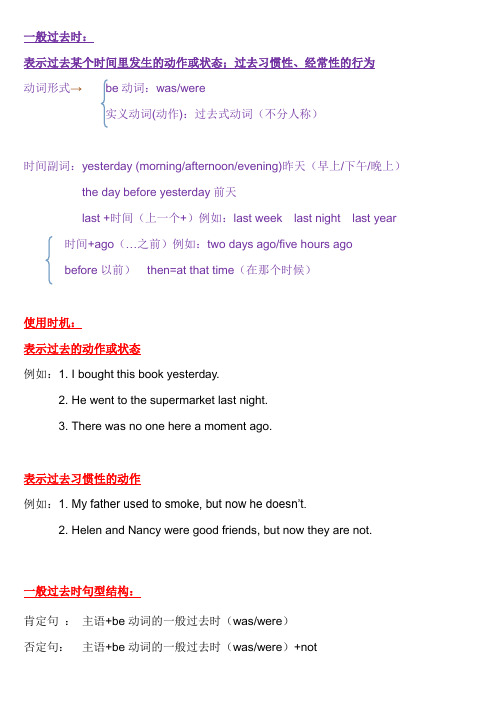
一般过去时:表示过去某个时间里发生的动作或状态;过去习惯性、经常性的行为动词形式→ be动词:was/were实义动词(动作):过去式动词(不分人称)时间副词:yesterday (morning/afternoon/evening)昨天(早上/下午/晚上)the day before yesterday前天last +时间(上一个+)例如:last week last night last year 时间+ago(…之前)例如:two days ago/five hours agobefore以前)then=at that time(在那个时候)使用时机:表示过去的动作或状态例如:1. I bought this book yesterday.2. He went to the supermarket last night.3. There was no one here a moment ago.表示过去习惯性的动作例如:1. My father used to smoke, but now he doesn’t.2. Helen and Nancy were good friends, but now they are not.一般过去时句型结构:肯定句:主语+be动词的一般过去时(was/were)否定句:主语+be动词的一般过去时(was/were)+not一般疑问句:be动词的一般过去时(was/were)+主语动词过去式变化规则:1.一般情况下,动词词尾加-ed, 如:work—worked want—wanted ask—asked2.以不发音的-e结尾动词,动词词尾加-d, 如:live—lived move—moved taste—tasted 3.以“辅音字母+y”结尾的动词,把y改成i, 加—ed, 如:study—studies try—tried copy—copied carry—carried4.重读闭音节动词,词尾为辅音+元音+辅音,双写词尾辅音字母,再加—ed, 如:stop—stopped动词过去式不规则变化:(is am) — was are — were do — did (have has) —hadgo—went meet—met come—came take—took steal—stole eat—ate fly—flew run—ran see—saw say—said make—made find—found stand—stood sit—sat sing—sang drink—drank give—gave ring—rang swim—swam write—wrote ride—rode drive—drove draw—drew grow—grew know—knew get—got forget—forgot sweep—swept keep—kept sleep—slept speak—spoke break—broke tell—told sell—sol dbuy—bought think—thought catch—caught teach—taught build—built can—could shall—should will—would过去式与动词原形一样:let—let must—must put—put read—read。
高中英语语法一般过去时详细讲解
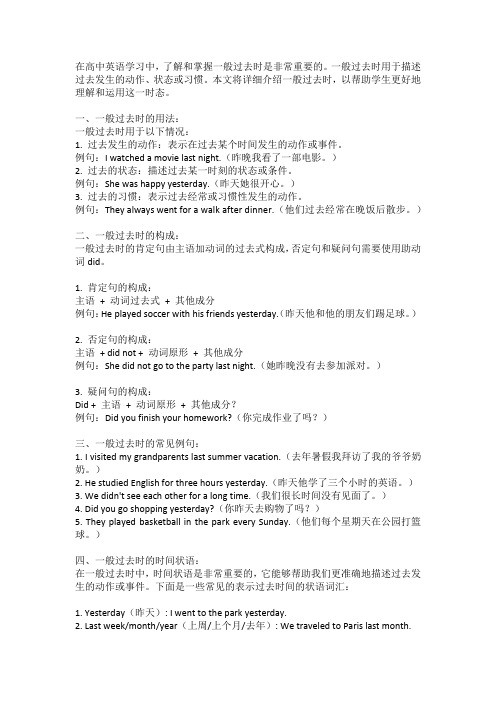
在高中英语学习中,了解和掌握一般过去时是非常重要的。
一般过去时用于描述过去发生的动作、状态或习惯。
本文将详细介绍一般过去时,以帮助学生更好地理解和运用这一时态。
一、一般过去时的用法:一般过去时用于以下情况:1. 过去发生的动作:表示在过去某个时间发生的动作或事件。
例句:I watched a movie last night.(昨晚我看了一部电影。
)2. 过去的状态:描述过去某一时刻的状态或条件。
例句:She was happy yesterday.(昨天她很开心。
)3. 过去的习惯:表示过去经常或习惯性发生的动作。
例句:They always went for a walk after dinner.(他们过去经常在晚饭后散步。
)二、一般过去时的构成:一般过去时的肯定句由主语加动词的过去式构成,否定句和疑问句需要使用助动词did。
1. 肯定句的构成:主语+ 动词过去式+ 其他成分例句:He played soccer with his friends yesterday.(昨天他和他的朋友们踢足球。
)2. 否定句的构成:主语+ did not + 动词原形+ 其他成分例句:She did not go to the party last night.(她昨晚没有去参加派对。
)3. 疑问句的构成:Did + 主语+ 动词原形+ 其他成分?例句:Did you finish your homework?(你完成作业了吗?)三、一般过去时的常见例句:1. I visited my grandparents last summer vacation.(去年暑假我拜访了我的爷爷奶奶。
)2. He studied English for three hours yesterday.(昨天他学了三个小时的英语。
)3. We didn't see each other for a long time.(我们很长时间没有见面了。
语法部分(二)一般过去时
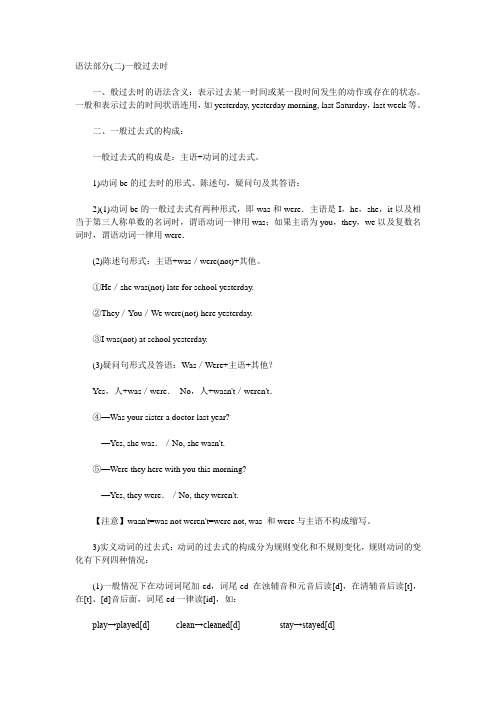
语法部分(二)一般过去时一、般过去时的语法含义:表示过去某一时间或某一段时间发生的动作或存在的状态。
一般和表示过去的时间状语连用,如yesterday, yesterday morning, last Saturday,last week等。
二、一般过去式的构成:一般过去式的构成是:主语+动词的过去式。
1)动词be的过去时的形式、陈述句,疑问句及其答语:2)(1)动词be的一般过去式有两种形式,即was和were.主语是I,he,she,it以及相当于第三人称单数的名词时,谓语动词一律用was;如果主语为you,they,we以及复数名词时,谓语动词一律用were.(2)陈述句形式:主语+was/were(not)+其他。
①He/she was(not) late for school yesterday.②They/You/We were(not) here yesterday.③I was(not) at school yesterday.(3)疑问句形式及答语:Was/Were+主语+其他?Yes,人+was/were.No,人+wasn't/weren't.④—Was your sister a doctor last year?—Yes, she was./No, she wasn't.⑤—Were they here with you this morning?—Yes, they were./No, they weren't.【注意】wasn't=was not weren't=were not, was 和were与主语不构成缩写。
3)实义动词的过去式:动词的过去式的构成分为规则变化和不规则变化,规则动词的变化有下列四种情况:(1)一般情况下在动词词尾加-ed,词尾-ed在浊辅音和元音后读[d],在清辅音后读[t],在[t]、[d]音后面,词尾-ed一律读[id],如:play→played[d]clean→cleaned[d] stay→stayed[d]ask→asked [t] cook→cooked [t] watch→watched[t]need→needed[id]want→wa nted[id] visit→visited[id](2)词尾是e的动词加-d。
英语学习:一般过去时语法解释大全
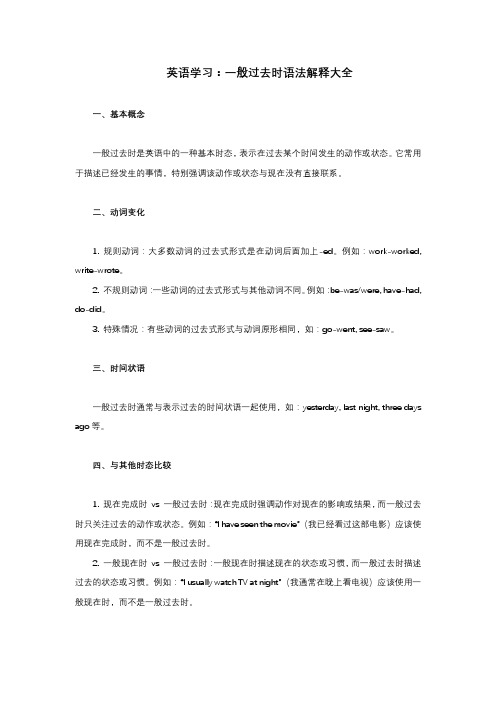
英语学习:一般过去时语法解释大全一、基本概念一般过去时是英语中的一种基本时态,表示在过去某个时间发生的动作或状态。
它常用于描述已经发生的事情,特别强调该动作或状态与现在没有直接联系。
二、动词变化1. 规则动词:大多数动词的过去式形式是在动词后面加上-ed。
例如:work-worked, write-wrote。
2. 不规则动词:一些动词的过去式形式与其他动词不同。
例如:be-was/were, have-had, do-did。
3. 特殊情况:有些动词的过去式形式与动词原形相同,如:go-went, see-saw。
三、时间状语一般过去时通常与表示过去的时间状语一起使用,如:yesterday, last night, three days ago等。
四、与其他时态比较1. 现在完成时vs 一般过去时:现在完成时强调动作对现在的影响或结果,而一般过去时只关注过去的动作或状态。
例如:“I have seen the movie”(我已经看过这部电影)应该使用现在完成时,而不是一般过去时。
2. 一般现在时vs 一般过去时:一般现在时描述现在的状态或习惯,而一般过去时描述过去的状态或习惯。
例如:“I usually watch TV at night”(我通常在晚上看电视)应该使用一般现在时,而不是一般过去时。
五、特殊用法1. 表达过去的经验:例如:“I visited Paris last year”(我去年参观了巴黎)。
2. 表达假设条件:例如:“If I were you, I would do it”(如果我是你,我会去做这件事)。
六、与过去进行时的区别1. 时间焦点:过去进行时强调在过去某一段时间正在发生的动作,而一般过去时描述过去的某个时间点发生的动作。
2. 语态选择:过去进行时用于描述过去某个时刻正在进行的动作,通常使用进行体(was/were+动词ing形式),而一般过去时则直接使用动词的过去式形式。
一般过去时语法
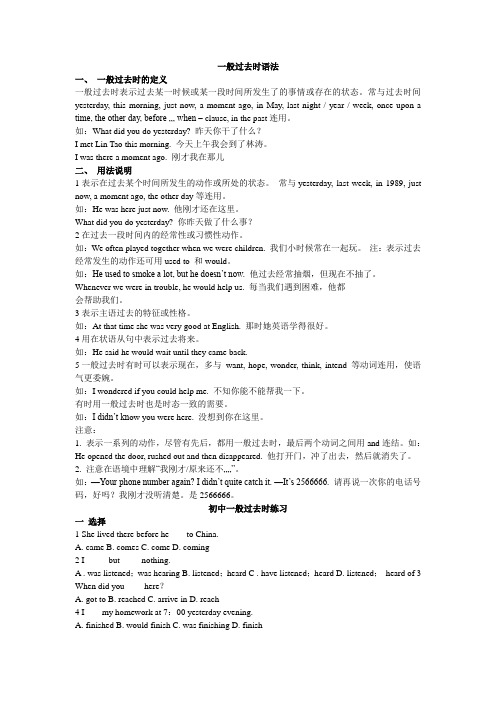
一般过去时语法一、一般过去时的定义一般过去时表示过去某一时候或某一段时间所发生了的事情或存在的状态。
常与过去时间yesterday, this morning, just now, a moment ago, in May, last night / year / week, once upon a time, the other day, before …, when – clause, in the past连用。
如:What did you do yesterday? 昨天你干了什么?I met Lin Tao this morning. 今天上午我会到了林涛。
I was there a moment ago. 刚才我在那儿二、用法说明1表示在过去某个时间所发生的动作或所处的状态。
常与yesterday, last week, in 1989, just now, a moment ago, the other day等连用。
如:He was here just now. 他刚才还在这里。
What did you do yesterday? 你昨天做了什么事?2在过去一段时间内的经常性或习惯性动作。
如:We often played together when we were children. 我们小时候常在一起玩。
注:表示过去经常发生的动作还可用used to 和would。
如:He used to smoke a lot, but he doesn’t now. 他过去经常抽烟,但现在不抽了。
Whenever we were in trouble, he would help us. 每当我们遇到困难,他都会帮助我们。
3表示主语过去的特征或性格。
如:At that time she was very good at English. 那时她英语学得很好。
4用在状语从句中表示过去将来。
英语语法一般过去时

英语语法一般过去时英语语法一般过去时一般过去时1)在确定的过去时间里所发生的动作或存在的状态。
时间状语有:yesterday, last week, an hour ago, the other day, in 1982等。
例:Where did you go just now?2)表示在过去一段时间内,经常性或习惯性的`动作。
例:When I was a child, I often played football in the street.Whenever the Browns went during their visit, they were givena warm welcome.3)句型:It is time for sb. to do sth 到时间了,该了It is time sb. did sth. 时间已迟了,早该了例:It is time for you to go to bed. 你该睡觉了。
It is time you went to bed. 你早该睡觉了。
would (had) rather sb. did sth. 宁愿某人做某事例:Id rather you came tomorrow.4)wish, wonder, think, hope 等用过去时,作试探性的询问、请求、建议等。
例:I thought you might have some. 我以为你想要一些。
【比较】一般过去时表示的动作或状态都已成为过去,现已不复存在。
Christine was an invalid all her life.(含义:她已不在人间。
)【英语语法一般过去时】。
英语一般过去时语法知识点总结(完整版)这一篇就够了

英语一般过去时语法知识点总结(笔记完整版)这一篇就够了1 一般过去时的定义总结1.1 描述发生在过去时间的事情或者动作。
The meeting started at 9 o’clock. 会议在9点就开始了。
1.2 表示在过去时间所存在的状态。
I was sick last month. 我上个月生病了。
1.3 表示发生在过去,但是已经结束的事件或者动作。
We had hamburger for lunch. 我们午饭吃了汉堡。
看下面表格区分一般过去时一般现在时和一般将来时一般过去时I was two years old then. 我那时候2岁。
一般现在时I am two years old now. 我现在2岁。
一般将来时I will be two years old next Monday. 到下周一我就2岁了。
2. 一般过去时的表现/结构形式。
在汉语中表示过去只需要说时间就可以了,过去的时间就表示过去。
比如,我昨天吃汉堡了。
就表示过去但是在英语中,表示过去除了加时间(有时候也不加),还需要在动词上体现出来。
具体有2种表现形式。
一种是在Be动词上体现,一种是在实义动词(能够独立做谓语的动词)上体现。
2.1 Be动词的一般过去时Be动词的一般过去时视主语不同,有2种was/were。
主语为单数或者我时,用was。
I was two years old last year. 我去年2岁She was two years old last year. 她去年2岁主语为复数或你时用were。
We were in the library this morning。
早上我们在图书馆You were thin last year。
你去年比较苗条。
Be动词过去时的肯定及否定肯定句结构:主语+was/were +否定句结构:主语+was/were +not+否定与的缩写结构was not = wasn’t , were not = weren’t例句:翠花去年是个胖子Cuihua was fat last year.翠花去年不胖Cuihua was not(wasn’t) fat last year.Be 动词过去时的一般疑问句,与常规一般疑问句一样,把Be动词提前即可。
一般过去时的英语语法
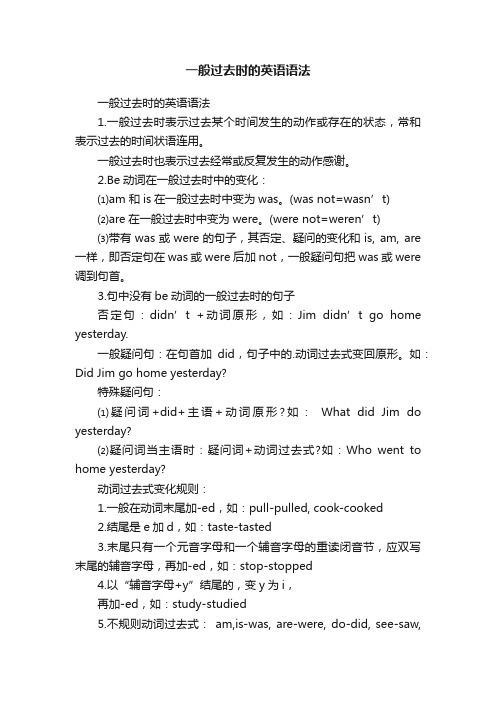
一般过去时的英语语法一般过去时的英语语法1.一般过去时表示过去某个时间发生的动作或存在的状态,常和表示过去的时间状语连用。
一般过去时也表示过去经常或反复发生的动作感谢。
2.Be动词在一般过去时中的变化:⑴am 和is在一般过去时中变为was。
(was not=wasn’t)⑵are在一般过去时中变为were。
(were not=weren’t)⑶带有was或were的句子,其否定、疑问的变化和is, am, are 一样,即否定句在was或were后加not,一般疑问句把was或were 调到句首。
3.句中没有be动词的一般过去时的句子否定句:didn’t +动词原形,如:Jim didn’t go home yesterday.一般疑问句:在句首加did,句子中的.动词过去式变回原形。
如:Did Jim go home yesterday?特殊疑问句:⑴疑问词+did+主语+动词原形?如:What did Jim do yesterday?⑵疑问词当主语时:疑问词+动词过去式?如:Who went to home yesterday?动词过去式变化规则:1.一般在动词末尾加-ed,如:pull-pulled, cook-cooked2.结尾是e加d,如:taste-tasted3.末尾只有一个元音字母和一个辅音字母的重读闭音节,应双写末尾的辅音字母,再加-ed,如:stop-stopped4.以“辅音字母+y”结尾的,变y为i,再加-ed,如:study-studied5.不规则动词过去式:am,is-was, are-were, do-did, see-saw,say-said, give-gave, get-got, go-went, come-came, have-had, eat-ate, take-took, run-ran, sing-sang, put-put, make-made, read-read, write-wrote, draw-drew, drink-drank, fly-flew, ride-rode, speak-spoke, sweep-swept, swim-swam, sit-sat 动词be(is,am,are)的用法我(I)用am, 你(you)用are,is跟着他(he),她(she),它(it)。
一般过去时的6大标志词是什么
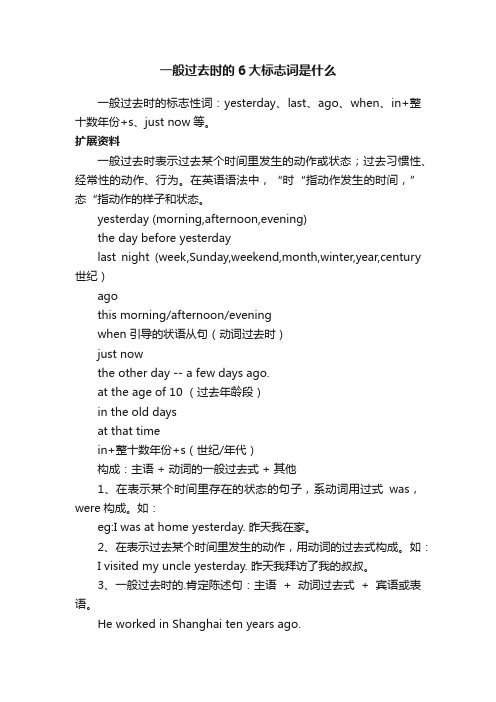
一般过去时的6大标志词是什么一般过去时的标志性词:yesterday、last、ago、when、in+整十数年份+s、just now等。
扩展资料一般过去时表示过去某个时间里发生的动作或状态;过去习惯性、经常性的动作、行为。
在英语语法中,“时“指动作发生的时间,”态“指动作的样子和状态。
yesterday (morning,afternoon,evening)the day before yesterdaylast night (week,Sunday,weekend,month,winter,year,century 世纪)agothis morning/afternoon/eveningwhen引导的状语从句(动词过去时)just nowthe other day -- a few days ago.at the age of 10 (过去年龄段)in the old daysat that timein+整十数年份+s(世纪/年代)构成:主语 + 动词的一般过去式 + 其他1、在表示某个时间里存在的状态的句子,系动词用过式was,were构成。
如:eg:I was at home yesterday. 昨天我在家。
2、在表示过去某个时间里发生的动作,用动词的过去式构成。
如:I visited my uncle yesterday. 昨天我拜访了我的叔叔。
3、一般过去时的.肯定陈述句:主语+动词过去式+宾语或表语。
He worked in Shanghai ten years ago.4、一般过去时的否定句:a.主语+didn’t +动词原形+宾语。
(did + not = didn't) He didn't do morning exercises yesterday.b.主语+wasn’t/weren’t +表语。
(was + not = wasn't , were + not = weren't)He wasn't an English teacher ten years ago.5、一般过去时的一般疑问句:a.Did +主语+动词原形+宾语?Did you study English in 1990 ?b.Was/Were + 主语+表语?Was he a pupil five years ago ?6、一般过去时的特殊疑问句:a.特殊疑问词+ did + 主语+动词原形+宾语?Where did your parents live five years ago?What did you do last Sunday?b.特殊疑问词+ were/was +表语?Who was at the zoo yesterday?。
一般过去时

一般过去时1一般过去时是英语语法中的一种时态,表示过去某个时间发生的动作或状态。
这种时态通常用于叙述过去发生的事情,或者描述过去某个时间点的状态。
在英语语法中,一般过去时的形式通常是通过动词的过去式来表示。
一、一般过去时的形式一般过去时的形式可以通过动词的过去式来表示,常用的过去式包括:be动词的过去式(was/were),do/does的过去式(did),have/has的过去式(had),go/come/fly的过去式(went/came/flew)等。
这些动词的过去式的基本形式是在动词后面加上-ed结尾。
二、一般过去时的用法1.表示过去某个时间发生的动作或状态。
例如:I went to the parkyesterday.(我昨天去了公园。
)2.表示过去某个时间点的状态。
例如:The book was on the table at 9o'clock yesterday morning.(昨天早上九点钟这本书在桌子上。
)3.叙述已经发生的事情,用于回忆或讲述历史。
例如:In the 1980s,computers were not widely used.(20世纪80年代,计算机还没有被广泛使用。
)4.表达过去的习惯或常规。
例如:My father used to go jogging everymorning.(我父亲过去每天早上都去慢跑。
)三、一般过去时的句式结构在英语中,一般过去时的句式结构通常包括主语+动词的过去式+宾语。
例如:1.They walked to the store yesterday.(昨天他们走路去商店。
)2.She played the piano for an hour yesterday afternoon.(昨天下午她弹了一个小时钢琴。
)3.We visited our grandparents last weekend.(上周末我们拜访了祖父母。
一般过去时-语法
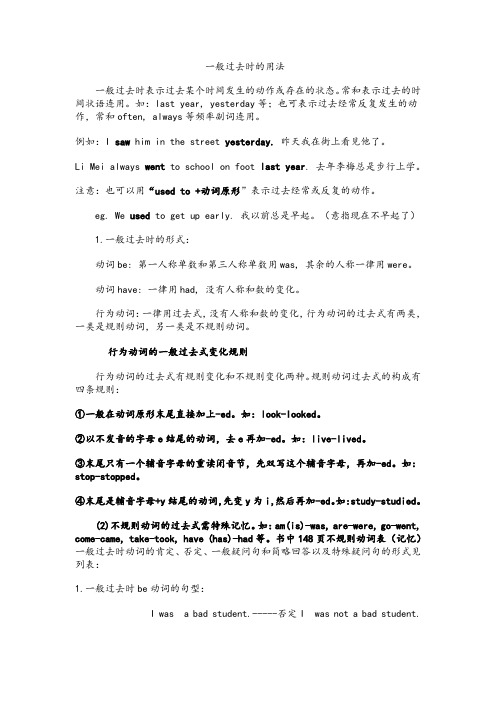
一般过去时的用法一般过去时表示过去某个时间发生的动作或存在的状态。
常和表示过去的时间状语连用。
如:last year, yesterday等;也可表示过去经常反复发生的动作,常和often, always等频率副词连用。
例如:I saw him in the street yesterday. 昨天我在街上看见他了。
Li Mei always went to school on foot last year. 去年李梅总是步行上学。
注意:也可以用“used to +动词原形”表示过去经常或反复的动作。
eg. We used to get up early. 我以前总是早起。
(意指现在不早起了)1.一般过去时的形式:动词be: 第一人称单数和第三人称单数用was, 其余的人称一律用were。
动词have: 一律用had, 没有人称和数的变化。
行为动词:一律用过去式,没有人称和数的变化,行为动词的过去式有两类,一类是规则动词,另一类是不规则动词。
行为动词的一般过去式变化规则行为动词的过去式有规则变化和不规则变化两种。
规则动词过去式的构成有四条规则:①一般在动词原形末尾直接加上-ed。
如:look-looked。
②以不发音的字母e结尾的动词,去e再加-ed。
如:live-lived。
③末尾只有一个辅音字母的重读闭音节,先双写这个辅音字母,再加-ed。
如:stop-stopped。
④末尾是辅音字母+y结尾的动词,先变y为i,然后再加-ed。
如:study-studied。
(2)不规则动词的过去式需特殊记忆。
如:am(is)-was, are-were, go-went, come-came, take-took, have (has)-had等。
书中148页不规则动词表(记忆)一般过去时动词的肯定、否定、一般疑问句和简略回答以及特殊疑问句的形式见列表:1.一般过去时be动词的句型:I was a bad student.-----否定I was not a bad student.He was a bad student----- 否定 he was not a bad studentYou were a bad student------ you were not a bad student.Be 动词的一般疑问:I was a bad student.-----疑问Were you a bad student?He was a bad student----- 疑问 Was he a bad student?You were a bad student------疑问Were you a bad student.?答语:yes, I was /No, I was not2.一般过去时行为动词的几种句型肯定句结构为:主语+动词的过去式+其他。
一般过去时讲解

一般过去时讲解
一般过去时的常见错误
时态不一致:在描述过去的事情时,容易将一些动作的时态与一般过去时不一致,导 致意思表达不清或产生歧义 动词形式错误:在使用一般过去时的时候,容易将动词的形式拼写错误或使用不当, 导致句子意思错误或语法错误
写作练习:通过写作练习来巩固一般过去时的运用。可以写日记、故事、短文等,记 录过去发生的事情,用一般过去时描述动作和状态。在写作过程中,注意时态的准确 性和语法的规范性
一般过去时讲解
口语练习
在口语练习中,尝试使用一般过去 时来描述过去的事情,表达对过去 的看法和回忆。可以通过模拟对话、 角色扮演等方式进行练习,提高对
pmห้องสมุดไป่ตู้ 我们原本打算下午3点在
火车站见面
03
表示过去的虚拟语气
在表示与现实相反的情况时, 可以使用一般过去时,表示虚 拟语气。例如:If I had known the answer, I would have told you. 如果我知道 答案的话,早就告诉你了。 (实际上不知道答案)
04
表示对过去的推测
在表示对过去的推测时,可以 使用一般过去时。例如:It must have rained last night, because the ground is wet. 昨晚一定下雨了,因 为地面是湿的
一般过去时讲解
一般过去时的其他注意事项
注意动词时态的一致性:在使用一般过去时的时候,要注意句子中其他动词的时态与 之一致。例如,在描述过去发生的事情时,所有的动作都应使用过去时态,除非有特 殊需要使用其他时态 注意动词的形式:在一般过去时中,动词需要使用其过去式形式。不同形式的动词过 去式有不同的拼写和发音,需要注意正确使用 注意时间状语的搭配:在使用一般过去时的时候,要与适当的时间状语进行搭配。例 如,"yesterday"应与一般过去时搭配使用,"tomorrow"应与一般将来时搭配使用
一般过去时语法总结归纳
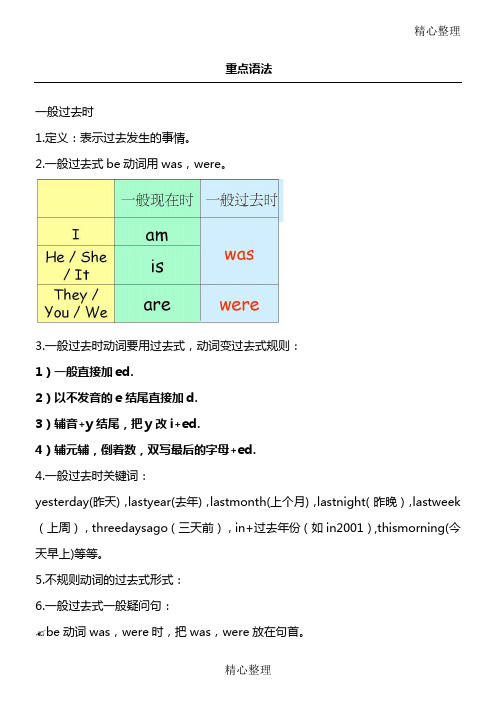
精心整理
重点语法
一般过去时
1.定义:表示过去发生的事情。
2.一般过去式be动词用was,were。
3.一般过去时动词要用过去式,动词变过去式规则:
1)一般直接加ed.
2)以不发音的e结尾直接加d.
3)辅音+y结尾,把y改i+ed.
4)辅元辅,倒着数,双写最后的字母+ed.
4.一般过去时关键词:
yesterday(昨天),lastyear(去年),lastmonth(上个月),lastnight(昨晚),lastweek (上周),threedaysago(三天前),in+过去年份(如in2001),thismorning(今天早上)等等。
5.不规则动词的过去式形式:
6.一般过去式一般疑问句:
be动词was,were时,把was,were放在句首。
精心整理
精心整理
精心整理
Wasthereany+可数名词单数或不可数名词....?
Yes,therewas./No,therewasn ’t.
Werethereany+可数名词复数.....?
Yes,therewere./No,thereweren ’t.
有动词时变一般疑问句,把Did 放句首,动词恢复原形。
Did+主语+动词原形....?
7.。
小学英语一般过去时语法详解
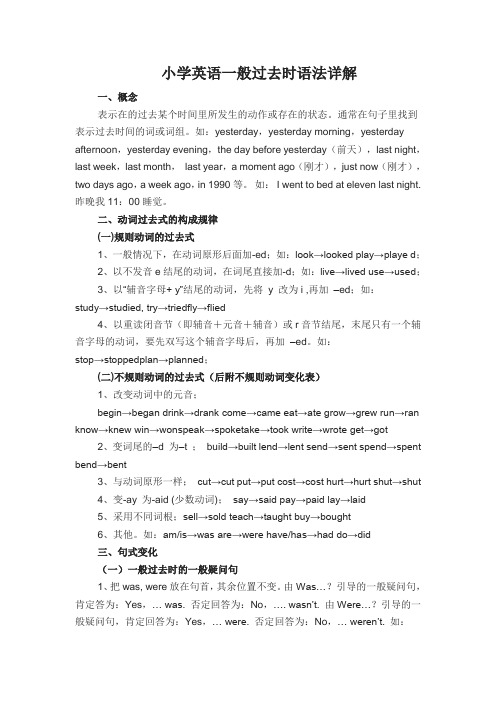
小学英语一般过去时语法详解一、概念表示在的过去某个时间里所发生的动作或存在的状态。
通常在句子里找到表示过去时间的词或词组。
如:yesterday,yesterday morning,yesterday afternoon,yesterday evening,the day before yesterday(前天),last night,last week,last month,last year,a moment ago(刚才),just now(刚才),two days ago,a week ago,in 1990等。
如:I went to bed at eleven last night.昨晚我11:00睡觉。
二、动词过去式的构成规律(一)规则动词的过去式1、一般情况下,在动词原形后面加-ed;如:look→looked play→playe d;2、以不发音e结尾的动词,在词尾直接加-d;如:live→lived use→used;3、以“辅音字母+ y”结尾的动词,先将y 改为i ,再加–ed;如:study→studied, try→triedfly→flied4、以重读闭音节(即辅音+元音+辅音)或r音节结尾,末尾只有一个辅音字母的动词,要先双写这个辅音字母后,再加–ed。
如:stop→stoppedplan→planned;(二)不规则动词的过去式(后附不规则动词变化表)1、改变动词中的元音;begin→began drink→drank come→came eat→ate grow→grew run→ran know→knew win→wonspeak→spoketake→took write→wrote get→got2、变词尾的–d 为–t ;bu ild→built lend→lent send→sent spend→spent bend→bent3、与动词原形一样;cut→cut put→put cost→cost hurt→hurt shut→shut4、变-ay 为-aid (少数动词);say→said pay→paid lay→laid5、采用不同词根;sell→sold teach→taught buy→bought6、其他。
- 1、下载文档前请自行甄别文档内容的完整性,平台不提供额外的编辑、内容补充、找答案等附加服务。
- 2、"仅部分预览"的文档,不可在线预览部分如存在完整性等问题,可反馈申请退款(可完整预览的文档不适用该条件!)。
- 3、如文档侵犯您的权益,请联系客服反馈,我们会尽快为您处理(人工客服工作时间:9:00-18:30)。
语法:一般过去时
一、一般过去时的意义和构成形式
一般过去时表示在过去某个时间发生的动作或存在的状态,也表示过去经常或
反复发生的动作。
构成形式:1、主语+was\were+其它
eg. They were in the classroom just now .
2、主语+行为动词过去式+其它
eg. He always went to work by bus last year 二、一般过去时常用的标志词语
yesterday (昨天), last week\year…(上周\去
年…), …ago(…以前), in\on+过去的时间,the
day before yesterday(前天) ,just now(刚才),
once upon a time(从前),then(那时).
三、一般过去时经常使用的场合
1、主要用于表述过去某个时间发生的动作或存在的
状态,句中常有表示过去的标志词语。
My parents worked in Wuhan in 2009.
2、表示过去一段时间内经常或反复发生的动作,常
与often, always等连用。
John always had lunch at school last term.
3、表示已故的人所做的事情。
Lao She wrote many great works in his life .
4、有些句子,虽然没有表示过去确定时间的状语,
但通过语境或语感可知某一动作已经发生,要用
过去时。
Why didn’t you come to the party?
5、表示过去所发生的一连串的动作。
My sister came into the room, turned on the
light and watched TV .
四、规则动词过去式变化规则
1.一般在动词末尾加-ed,如:play-played, cook-co
2.结尾是e加d,如:like-liked love-love
3.末尾只有一个元音字母和一个辅音字母的重读闭音节,应双写末尾的辅音字母,再加-ed,如:stop-stoppe
4.以“辅音字母+y”结尾的,变y为i,再加-ed,如:study-studied
五、四种句式的构成
1、一般过去时态的肯定句式“主语+动词过去式+其它”
例如:Jenny bought a skirt yesterday. 詹妮昨天买了一件短裙。
2、一般过去时态的否定句式“主语+didn’t+动词原形+其它”
例如:Jenny didn’t buy a skirt yesterday.詹妮昨天没有买短裙。
3、一般过去时态的一般疑问句式“Did+主语+动词原形+其它”
例如:Did Jenny buy a skirt yesterday? 詹妮昨天买短裙了吗?
4、一般过去时态的特殊疑问句式“疑问词+did +主语+动词原形+其它”
例如:What did Jenny buy yesterday? 詹妮昨天买了什么?
一般过去时态集中训练营
一训练第一关:小小单词难不到我。
请写出下列动词的过去式。
want wanted arrive arrived enjoy enjoyed shop -shopped------
buy bought _ see saw _ break broke_ 二训练第二关:生病的句子能奈我何?
请在仔细诊断每个句子后,把正确的句子写在横线上。
1. We went to school early
yesterday . _______________________________
____________
2. She bought a dress last week.
___________________________________________
3. Did you like playing football ?
___________________________________________
4.-Did you have a good trip ? -No, I didn’t.
___________________________________________
5. We didn’t fly kites last
month. ___________________________________________ 三训练第三关:翻译句子我最棒。
请将下列的汉语句子翻译成正确的英语。
1 你昨晚去哪了?
_______________________________________
我去了王府井的一家商店。
_____________________________
2 李明前天想给妈妈买件大衣,但他没有太多的钱。
3 我们去年在南京玩得不快乐。
___________________________________________。
